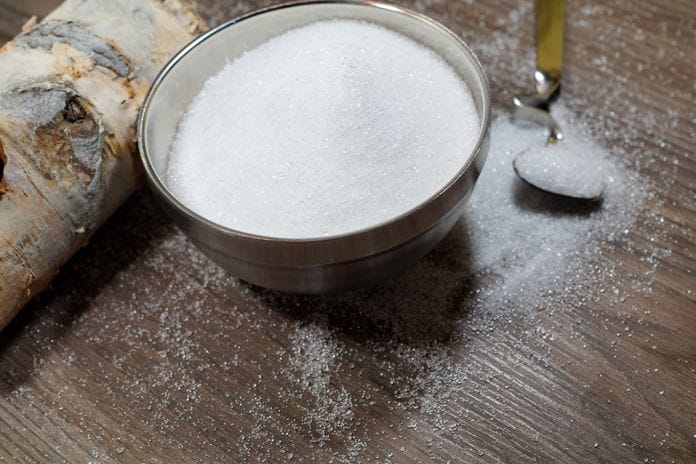There are only a few things in this world that people enjoy more than sweets, whether it be chocolate or even adding sugar to a daily cup of coffee. We humans just cannot seem to get enough. However, tooth decay is considered an epidemic in children in the USA. Further, sugar, and the inflammation caused by it, feeds many other conditions and diseases.
Not all sugar substitutes are created equal, and of course, a trial and error by each person must be attempted to find the right solution. Unlike other sugar substitutes, xylitol has a great chance of being used successfully in the battle of tooth decay.
History of Xylitol
In 1891, a German chemist by the name of Emil Fischer first chemically made xylitol using wood (D-xylose)4,6. However, its purity was questionable because it contained small amounts of sugar alcohols other than xylitol. Its discovery was uneventful, and xylitol remained just a research chemical until the 1930s and WWII. In the 1930s, chemists and engineers went on the hunt to find alternative sweeteners due to war-associated sugar shortages in countries such as Finland. Before xylitol’s purity and benefits were truly brought to full reality, and any large-scale xylitol production came to be, the sugar shortage ended when the war ended. Again, xylitol was put on the back burner.6
That is until 1975 when a Finnish company began the first large-scale production of the sugar alcohol. At the same time, a Swiss company had interest in manufacturing xylitol, so the two joined together in 1976 founding the company called Xyrofin. While this was happening, other companies in the former Soviet Union, China, Japan, Germany, and Italy, produced xylitol for domestic markets; before 1970 it was mostly used for diabetic diets or in parenteral nutrition.6
In 1975, the first xylitol chewing gum was launched in Finland. A few months later, the United States launched its first chewing gum with xylitol as well.6
Where does xylitol come from?
Xylitol is a naturally occurring sugar alcohol found in the fibers of many fruits, vegetables, the bark of birch trees, and other hardwood species that contain xylan. Raspberries, strawberries, yellow plum, lettuce, cauliflower, corn, and corn husks all contain natural xylitol.3 Plums, raspberries, and cauliflower contain relatively high quantities of xylitol (0.3-0.9 per 100 g dry matter, depending on the season and plant variety)5.
For commercial purposes, xylitol comes from corncobs or trees. Corncobs are more environmentally friendly and sustainable than trees, so corncobs as a xylitol source are preferred. Corncobs can be grown in five months as opposed to a tree taking 20 years to grow. Further, corncobs are often wasted at the end of the season, so using them for xylitol makes them environmentally friendly as well.5
Why is xylitol unique?
Xylitol is unique due to its chemical structure as compared to other sugars. Unlike carbohydrates, such as monosaccharides/simple sugars (i.e., glucose, fructose, galactose) and sorbitol or disaccharides/double sugars (i.e., sucrose/table sugar, lactose, maltose), xylitol has a 5-carbon structure as opposed to a 6-carbon structure6. Cariogenic bacteria have a hard time metabolizing 5-carbon xylitol. As bacteria ingest it, the xylitol molecule is transformed into xylitol phosphate; a compound bacteria cannot metabolize. This causes cariogenic bacteria to starve because, over time, the unmetabolized xylitol phosphate builds up within the bacteria and becomes toxic to them. This buildup interferes with the metabolic pathways bacteria rely on for nourishment, leaving cariogenic bacteria to either become malnourished or starved, thus reducing bacterial counts creating less acidic waste. To summarize, a decrease in cariogenic bacteria in plaque correlates with a decrease in levels of acidic by-products which form through the metabolism of sugars.1
Long-term exposure to xylitol influences which type of cariogenic bacteria dominates in a person’s mouth. Cariogenic bacteria are more xylitol-sensitive, whereas xylitol-resistant bacteria are less able to cause dental decay; this is partly because xylitol-resistant bacteria are less capable of adhering and forming colonies, which lowers the risk of decay. Reduction in the level of bacteria can also lessen overall plaque levels. With fewer bacteria, and less acidic bi-products being produced, a more pH-balanced environment results. Because bacteria tend to thrive best in acidic environments, this allows for remineralization to occur more often. Evidence suggests that xylitol can assist in moving calcium ions, especially in middle and deep layers of enamel, assisting in demineralization as well.1
Who can benefit from xylitol?
Xylitol can be beneficial for people with high decay rate and risk. It seems that there are so many different groups of people being affected by tooth decay; from a small child that is allowed to snack all day long or a senior patient that has exposed root surfaces; many can be helped by introducing xylitol to their caretakers or the patients themselves. Because xylitol is available in many forms, it is easy to add to a daily routine. Chewing xylitol gum, or even using a xylitol mint, after meals can help reduce food debris and plaque, increase saliva flow, and inhibit the growth of bacteria1. It is easy to see if you look online, or even at the booths of your favorite dental convention, that xylitol is very widely marketed and quite easy to order or buy in your favorite store. Xylitol seems to show promise, even greater when added to fluoride toothpaste, in reducing tooth decay2. It seems worth the effort of trying to get our patients interested in and using xylitol products to help themselves.
Another group of people that can greatly benefit from the regular use of xylitol are those with xerostomia. From our patients using prescriptions drugs, where xerostomia is a common side effect, to a person going through chemotherapy, a wide range of people are suffering from a dry mouth. Sometimes, a patient may not feel the effects of xerostomia, and it may be up to their dental hygienist or another clinician, to discuss the problems that can arise from xerostomia. Having a dry mouth can not only be uncomfortable but brings along other risk factors such as mouth sores, thrush, cracked lips, poor chewing and swallowing, as well as increased tooth decay3. Recommending, and even dispensing samples of xylitol products, along with directions on use, can help our patients handle a very common problem. Many patients have never heard of things like xylitol mints or dry mouth sprays, and usually, do not know where they can purchase such products.
Xylitol can also benefit people with diabetes as a sugar substitute because it does not increase blood sugar levels. Xylitol is absorbed more slowly than sugar and metabolized independently of insulin4. Because of the insulin-independent nature of xylitol, it has been used in Germany, Switzerland, Russia, and Japan as a sweetener for diabetic diets since the 1960’s5.
Research shows promise in xylitol’s effectiveness in preventing and decreasing the need for antibiotics in acute otitis media (middle ear infections) in children4,7,8. In vitro studies show xylitol is effective in inhibiting the growth of S. pneumoniae9 and reduces the adherence of S. pneumoniae and H. influenza to nasopharyngeal epithelial cells10. Further, studies show that xylitol is more effective than glucose during parenteral nutrition following trauma or sepsis. Other efficacious uses for xylitol shown through research include osteoporosis, prolonging life in sepsis caused by S. pneumoniae, and intestinal sepsis.4
It is estimated that Americans consume 68.5 pounds of sugar, per person, per year. As hygienists, we all know the detrimental dental effects of sugar and how excess sugar can lead to weight gain, which can lead to diabetes and obesity; excess consumption of sugar can also raise blood pressure, triglyceride, and bad cholesterol levels, increasing the risk of heart disease, among other systemic effects. Children who consume excess sugar can have issues with concentration and learning as well. Xylitol can be used for anyone trying to lower their sugar consumption and cut calories from sugar; it has about 40% fewer calories and 75% fewer carbohydrates than sucrose/sugar.5
What are forms of xylitol and what’s the recommended dosage?
Xylitol is available in several forms for oral use. Gum, mints, mouth sprays, and rinses are among the most common. It is easy for a person to try several different forms, and to decide which is the easiest to fit into their lifestyle, as well as which one is most effective for the condition that they are working on improving.
Studies show that an ideal range of xylitol use for prevention of caries in adults is approximately 6.9 to 10.3 grams spread throughout each day, which is about two tsp. Dosages of 3.5 grams or less seem to be ineffective. Xylitol use in children seems to be effective in decay reduction at 3 to 8 grams throughout the day and children under the age of 4 can be given syrup or jam containing xylitol to prevent possible choking on mints or swallowing gum.1
Are there side effects of consuming xylitol and is xylitol safe?
It must be noted that with xylitol, there can be some situations where side effects, such as gastric distress, can be felt by some people. Gastric distress normally happens when large doses, those higher than necessary to achieve dental benefits, are taken at once. However, diabetic people have been found to consume up to 70 g of xylitol per day without any adverse reactions.6 If gastric distress does occur, it can be overcome by implementing smaller doses at first, working a person’s way up to a higher dose as the body adjusts to exposure to xylitol. It should be noted that xylitol occurs naturally in human bodies; an average-sized adult manufactures up to 15 grams of xylitol per day during normal metabolism3.
Various international and national regulatory authorities have assessed the safety of xylitol. As an example, back in 1983, the Joint Expert Committee on Food Additives of two United Nations agencies (FAO and WHO), indicated that the “Acceptable Daily Intake” for xylitol is “not specified,” meaning there are no special consumption limits needed for xylitol. In 1986, the Federation of American Societies for Experimental Biology, based on comprehensive literature reviews and the scientific opinions of knowledgeable investigators engaged in work in relevant areas of biology and medicine, reported that there are no significant safety concerns for the use of xylitol in humans. Further stating that xylitol appears to have the same safety profile as other sugar alcohols (i.e., sorbitol, D-mannitol).6 With that said, keep xylitol away from dogs, as they metabolize xylitol differently than humans, and it is toxic and can be lethal to them.
In summary
I believe that together, the dental community can make a huge change in the current rate of tooth decay by educating our patients on xylitol. Not only can we educate, but we can also arm our patients with products that can make a difference. Information will spread from our patients to their families and friends, and we can make tooth decay a small problem instead of the rampant destruction of its current state.
Because sugar alcohols have many benefits in overall health, spreading this information to as many patients as possible can lead to positive outcomes both dentally and in overall health. Our patients fill out health forms; use a patient’s health history as a tool and discuss things like diabetes and using sugar substitutes for their health benefits. This can be a way to bring information into your patient’s life that could have more than one positive change in their overall health.
NOW READ: Oil Pulling: Should We Recommend It Yet?
References
- How to Prevent Tooth Decay Using Nature’s Table Sugar Substitute. Retrieved from https://www.xylitolpreventscavities.com/.
- Sano, H., Nakashima, S., Songpaisan, Y., Phantumvanit, P. (Mar 2007). Effect of a Xylitol and Fluoride Containing Toothpaste on the Remineralization of Human Enamel In Vitro. Journal of Oral Science, 49(1): 67-73. Retrieved from https://www.ncbi.nlm.nih.gov/pubmed/17429185.
- Dry Mouth: Causes, Symptoms, and Treatment. (Dec 2017). WebMD. Retrieved from https://www.webmd.com/oral-health/ss/slideshow-dry-mouth.
- Xylitol. (2009). Drugs.com. Retrieved from https://www.drugs.com/npp/xylitol.html.
- What is Xylitol. Xylitol.org. Retrieved from https://xylitol.org/what-is-xylitol/.
- Greene, W. Xylitol – Nature’s Healthy Sweetener. DC Nutrition. Retrieved from https://www.dcnutrition.com/miscellaneous-nutrients/xylitol-natures-healthy-sweetener/.
- Uhari, M., Kontiokari, T., Niemela, M. (Oct 1998). A Novel Use of Xylitol Sugar in Preventing Acute Otitis Media. Pediatrics, 102(4 Pt 1): 879-84. Retrieved from https://www.ncbi.nlm.nih.gov/pubmed/9755259.
- Azarpazhooh, A., Lawrence, H.P., Shah, P.S. (Aug 2016). Xylitol for Preventing Acute Otitis Media in Children up to 12 Years of Age. Cochrane Database Systemic Review, 3;(8): CD007095. doi: 10.1002/14651858.CD007095.pub3. Retrieved from https://www.ncbi.nlm.nih.gov/pubmed/27486835.
- Terhi, T., et al. (Jan 2001). Effect of Xylitol on Growth of Streptococcus pneumoniae in the Presence of Fructose and Sorbitol. American Society for Microbiology: Antimicrobial Agents and Chemotherapy, 45(1): 166–169. Retrieved from https://www.ncbi.nlm.nih.gov/pmc/articles/PMC90255/.
- Kontiokari, T., Uhari, M., Koskela, M. (Aug 1995). Effect of Xylitol on Growth of Nasopharyngeal bacteria In Vitro. American Society for Microbiology: Antimicrobial Agents and Chemotherapy, 39(8): 1820-3. Retrieved from https://www.ncbi.nlm.nih.gov/pubmed/7486925.












